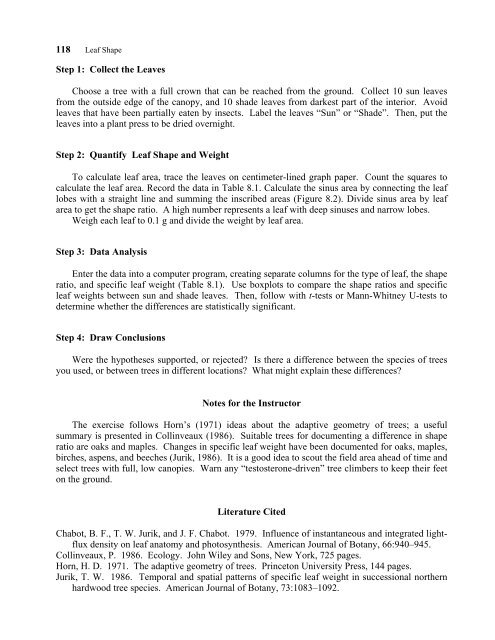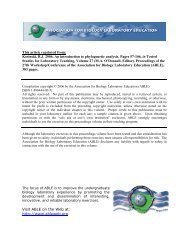Developmental Plasticity in Oak Leaves David Westmoreland
Developmental Plasticity in Oak Leaves David Westmoreland
Developmental Plasticity in Oak Leaves David Westmoreland
You also want an ePaper? Increase the reach of your titles
YUMPU automatically turns print PDFs into web optimized ePapers that Google loves.
118 Leaf Shape<br />
Step 1: Collect the <strong>Leaves</strong><br />
Choose a tree with a full crown that can be reached from the ground. Collect 10 sun leaves<br />
from the outside edge of the canopy, and 10 shade leaves from darkest part of the <strong>in</strong>terior. Avoid<br />
leaves that have been partially eaten by <strong>in</strong>sects. Label the leaves “Sun” or “Shade”. Then, put the<br />
leaves <strong>in</strong>to a plant press to be dried overnight.<br />
Step 2: Quantify Leaf Shape and Weight<br />
To calculate leaf area, trace the leaves on centimeter-l<strong>in</strong>ed graph paper. Count the squares to<br />
calculate the leaf area. Record the data <strong>in</strong> Table 8.1. Calculate the s<strong>in</strong>us area by connect<strong>in</strong>g the leaf<br />
lobes with a straight l<strong>in</strong>e and summ<strong>in</strong>g the <strong>in</strong>scribed areas (Figure 8.2). Divide s<strong>in</strong>us area by leaf<br />
area to get the shape ratio. A high number represents a leaf with deep s<strong>in</strong>uses and narrow lobes.<br />
Weigh each leaf to 0.1 g and divide the weight by leaf area.<br />
Step 3: Data Analysis<br />
Enter the data <strong>in</strong>to a computer program, creat<strong>in</strong>g separate columns for the type of leaf, the shape<br />
ratio, and specific leaf weight (Table 8.1). Use boxplots to compare the shape ratios and specific<br />
leaf weights between sun and shade leaves. Then, follow with t-tests or Mann-Whitney U-tests to<br />
determ<strong>in</strong>e whether the differences are statistically significant.<br />
Step 4: Draw Conclusions<br />
Were the hypotheses supported, or rejected? Is there a difference between the species of trees<br />
you used, or between trees <strong>in</strong> different locations? What might expla<strong>in</strong> these differences?<br />
Notes for the Instructor<br />
The exercise follows Horn’s (1971) ideas about the adaptive geometry of trees; a useful<br />
summary is presented <strong>in</strong> Coll<strong>in</strong>veaux (1986). Suitable trees for document<strong>in</strong>g a difference <strong>in</strong> shape<br />
ratio are oaks and maples. Changes <strong>in</strong> specific leaf weight have been documented for oaks, maples,<br />
birches, aspens, and beeches (Jurik, 1986). It is a good idea to scout the field area ahead of time and<br />
select trees with full, low canopies. Warn any “testosterone-driven” tree climbers to keep their feet<br />
on the ground.<br />
Literature Cited<br />
Chabot, B. F., T. W. Jurik, and J. F. Chabot. 1979. Influence of <strong>in</strong>stantaneous and <strong>in</strong>tegrated lightflux<br />
density on leaf anatomy and photosynthesis. American Journal of Botany, 66:940–945.<br />
Coll<strong>in</strong>veaux, P. 1986. Ecology. John Wiley and Sons, New York, 725 pages.<br />
Horn, H. D. 1971. The adaptive geometry of trees. Pr<strong>in</strong>ceton University Press, 144 pages.<br />
Jurik, T. W. 1986. Temporal and spatial patterns of specific leaf weight <strong>in</strong> successional northern<br />
hardwood tree species. American Journal of Botany, 73:1083–1092.
















